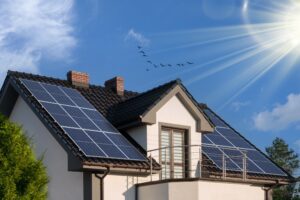Voltage optimisers are self-explanatory in terms of function, but in purpose, are designed to save energy by ensuring the voltage that is supplied to electrical equipment and systems is most efficient. Inefficient voltages result in needlessly high electricity consumption, leading to higher bills.
This is why Effective Home has compiled this guide. Here we outline voltage optimisation solutions in detail, including their installation process, how to choose the right voltage optimisers plus the overall difference they make.
What are voltage optimisers?
Voltage optimisation are energy efficiency devices installed within an electrical system, typically within the central area. They work automatically by adjusting the incoming power supply to the actual requirements of connected electrical appliances to the ideal voltage.
There are three different types of voltage optimisation technology.
- Residential voltage optimisers – These optimisers are designed to fit within domestic environments. They are smaller and less obtrusive, allowing them to be fitted in limited spaces such as your utility room.
- Commercial voltage optimisers – These optimisers are built bigger, with more sophisticated control. This is because commercial operations typically have more electricity demand than a normal household does. As such, you can expect commercial voltage optimisers to have advanced controls, such as phase balancing and power factor correction, meeting the demanding needs of a business.
- Dynamic voltage optimisers – These voltage optimisers are best used in settings that are specialised, and require a sophisticated device that can meet the dynamic and wildly changing demands of a setting. It’s often integrated with smart technology to enable remote monitoring and control over your electrical equipment performance.
Why should I consider a voltage optimiser?
Voltage optimisation has four big benefits for both residential and commercial properties to consider.
- Significant Energy savings – The most obvious of the four benefits that you’ll get out of voltage optimisers is energy saving. By optimising and not wasting your energy, the British Power Group considers you likely to yield average energy savings to be within the range of 8-19%. The power demand will remain the same, but your energy savings will not – as the electrical equipment itself will cost less to run.
- Electrical Equipment lifespan – Energy is drawn from the grid without care for how much voltage your electrical equipment is designed to take, so long as it doesn’t break them. In truth, every time you use a voltage that is over what is recommended, you do minuscule damage to your systems. The higher the energy consumption, the more damage it does.
- Carbon footprint reduction – Carbon, overall, is harmful to the planet. That is why the UK is trying to reduce levels of carbon release. One of those ways is to make the usage of electricity consumption as efficient as possible.
- Improved Power Quality – By stabilising the supply and reducing overall electrical noise in the system, the power quality becomes noticeable. Whereas fluctuations can cause electrical noises and issues within electrical equipment, smoothing out these fluctuations not only ensures that this is minimised, but it makes you feel as if you’re using a modern machine again.
How do I know if I need a voltage optimiser?
The following are some of the factors you should consider when trying to determine whether you should get a voltage optimiser.
Factors to consider:
- Existing voltage levels – If you find out that your supply voltage (the voltage of your electricity supply) is high for your area, then you will be one of the selection of people who would benefit from the higher benchmark figures of energy savings from voltage reduction. Some electrical companies will be able to tell you the voltage drawn, but failing that, consulting a professional or installing a multimeter/voltmeter is the only way to do this.
- Energy costs – High energy bills are an indicator that something is wrong. Your utility bills will list how much you’re spending on energy consumption, but may not go into specifically what type of energy or where from. Aside from calling and inquiring with your energy supplier, there is experimentation you could do, as well as paying for your energy as you go.
How to install a voltage optimiser
Whilst it could be possible in theory to install a voltage optimiser as a DIY job, the reality is that it must be installed by a qualified electrician. This is why we always, always recommend that you go with a trusted professional.
Nonetheless, below is the process that one of our trusted professionals will go through to ensure your home’s energy consumption is optimised.
Site Assessment
The site assessment is a mandatory first step. We will begin by measuring the current voltage being drawn into the property, ensuring that they’re higher than normal. This is done using specialised equipment that can record the voltage over some time. The measured supply voltage is then compared to the standard operating voltage of the equipment in use.
The assessment also includes something called a load analysis. This involves identifying the main electrical loads in the property. By understanding which loads are higher than others, and which systems/devices are the primary consumers of electricity, a priority list of areas most in need of a voltage optimiser is made.
Based on the information secured and calculated, the sizes and types of voltage optimisers required are determined.
Location Selection
Once the voltage optimiser required is chosen, it’s time to find the best possible area to place the optimiser. This area has met three criteria:
- Accessible – The optimiser being accessible is very important. This is not only so that you can access it whenever you need to, but also so that necessary maintenance work is done. On top of that, some optimisers have monitoring capabilities that you could want to access. Either way, an optimiser is not a device that you install and forget about, but a part of your long-term living.
- Secure – Optimisers, despite not exactly being a target for theft or tampering, should still be placed in a location that cannot be broken into so easily. This prevents tampering. Additionally, ensure that it’s protected from the elements and environment. The area should be dry, away from extreme temperatures and direct sunlight.
- Mains Electricity Supply – It has to be close to the main electricity supply. This optimises the incoming voltage, making the majority of energy consumed in the home much lower. This allowed the optimised voltage to be distributed throughout the entire household.
Installation
The installation won’t involve customer participation, but it does require a couple of things.
- Energy Shutdown – Temporarily, you will need to turn off the electricity coming into the house. This is so that no injuries will occur, and that your electrics system is not damaged. Of course, the time period in which this will take place will be confirmed ahead of time.
- Secure Mounting – In the chosen location, the utiliser will be mounted on a secure racking. This mounting ensures the device is stable and immune from accidental damage.
- Electrical Connections – Connections are to be installed between the incoming electrical supply, as well as the outgoing load side. The optimiser will act as a go-between, ensuring that it tweaks the voltage to be efficient.
- Testing – After the optimiser is hooked up, it’s now time to test the fruits of the labour. Several tests using specialised equipment will be made to ensure that the voltage is being reduced to the correct level.
Maintenance and Care
Maintaining a voltage optimiser is a simple affair. Check the unit now and again to ensure that no external damage has been taken and that the area around the optimiser remains clear. Blocking in the optimiser, after all, could result in overheating.
If your optimiser comes with a built-in indicator and/or a monitoring system, then you can use these systems to look out for any issues early. It’s more than likely that if anything is going wrong internally, you will be notified by the optimiser, as well as the best way to fix it.
Voltage Optimisers – FAQs
What’s the difference between voltage optimisers and power factor correction units?
These are similar devices in terms of objective, but not in operation. A power factor correction unit is built to improve the “power factor” of your system. To put it in layman’s terms, it basically allows you to use the energy you draw for more.
Whilst this is effectively the same in terms of efficiency, it does it differently, by essentially making the flow of energy smoother. This means that you can use both at the same time.
Can a voltage optimiser protect against power surges?
The answer to this question is both yes and no. Power surges typically happen when there’s a sudden spike in electrical voltage, and often occur in power being knocked offline and/or damage being sustained on electrical devices.
By regulating the supply voltage of incoming electricity, you essentially cut off any chance of power surges happening from the main source of the electrical supply. Even if one were to occur, the optimiser would be able to reduce the surge to a manageable level, meaning you may not even notice the surge when it happens, and almost completely negates the possibility of an electrical appliance being damaged.
That being said, an optimiser cannot be expected to protect your home from power surges that occur from outside of the main electrical supply or happen as a result of major mishaps. For example, lightning strikes.
How long does it take to install a voltage optimiser?
A voltage optimiser’s installation time varies based on how complex the electrical system is, as well as the specifics of the installation site. The average for the typical voltage optimiser installation is typically around half a day. How simple residences and optimiser models, you could be looking at as little as a few hours. At worst, you’re expected to be waiting for nearly a full day.
Nonetheless, after the initial home assessment, you can expect to be told the expected duration of the job.
How often does an optimiser need servicing?
The servicing frequency of your optimiser will be stated within the manufacturer’s instructions. That being said, we often are asked to service an optimiser every year based on a care package.
The annual service includes:
- Visual Inspections – Checking for visible signs of wear, damage or overheating.
- Energy Consumption Check – Ensuring that your power consumption is optimal.
- Connection – This involves the verification of all cables and connection security.
- Cleaning – Removing dust or debris from the optimiser or case.
- Software updates – Modern optimisers are typically controlled via a smart system, but provided it is not, we will update the model.



